
Cypher System Rulebook Pre-order PDF on RPGNow
Sitting down to read – and then review – the Cypher System Rulebook from Monte Cook Games, it had me thinking: what are gamers expecting from this core generic package that they haven’t got in their hands already?
The original Numenera setting had a very specific focus and provided the first look at the Cypher system. The Strange – the second highly successful Kickstarter – offered something a little more generic than the Ninth World, expanding the range of options available to encompass the diverse worlds accessible through pocket dimension hopping. Between these two games, we’ve also had Character Options, Bestiaries, Cypher Books and a dozen or so Glimmers, covering everything from Sex in the Ninth World to Lovecraftian nightmares.
What could the Cypher System Rulebook offer?
Upfront on Review
I’m writing this review based on reading a pre-release proof. I have had a chance to tinker around with character generation, but not yet run the game direct from the text. I have run both Numenera and The Strange – and, therefore, can make judgements and comparisons based on experience as a GM and player of other Cypher-driven games.
Some of my focus in this review comes from asking people what they hoped the new book would offer them. My thanks to those who answered my open and somewhat vague questions about this on Google+.
Form
You might be expecting a pamphlet, right? OK, you know I’m kidding. The pre-release PDF of the Cypher System Rulebook comes to a hefty 416-pages. That’s precisely the same size as both the Numenera and The Strange core books. If you have concerns about the strength and stability of your shelving, now would be the time to invest in reinforcements. It’s about 100-pages more than the 5e D&D Player’s Handbook, but nothing compared to, say, Pathfinder or Mindjammer.
The physical feel and appearance of the book will doubtless mirror the previous books, with solid covers and slightly glossy pages, but I’m guessing. From the PDF alone, you have a richly illustrated volume that draws together more of the work from the familiar artists. Plenty of single character imagery to illustrate the sort of personalities you might play in the game, as well as flavourful encounter images and richly coloured backdrops.
The book follows the standard format of two-column pages with a thick margin on the outer page edge. The margin holds cross-references to other sections, background notes, alternate rule suggestions and GM Intrusions. The notes hold fluff or provide a means to quickly flip to a page with additional information. Handy for both players and gamemasters.
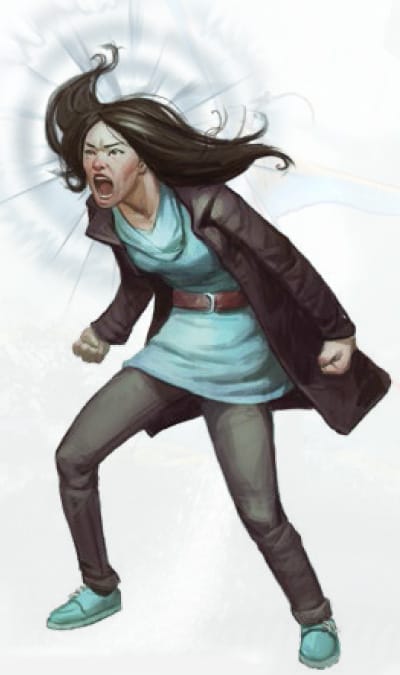 Features
Features
The Cypher System Rulebook presents the mechanics behind Numenera and The Strange without the setting. Monte Cook has looked to take his enthusiastically received system and serve it up as a generic game engine. The CSR has the simple core system present and correct, then plugs in a major dose of customisation and flexibility.
Upfront for People With Short Attention Spans
I’ve written quite a lot about this game, so you might want to know now whether you should buy it.
If you like layers of crunch, power gaming/munchkinism, GMs who roll dice, carefully balanced levels and advancement, and/or differentiation between your characteristics and health – the Cypher System probably isn’t for you. Also, if you have a limited budget and already own previous Cypher-based games, this book might not offer enough for you to justify the outlay (see Upfront for Fans, below).
If you like story-focussed fun with some rules and structure, roleplaying over ruleplaying, player agency, GMs who don’t roll dice, and/or can embrace a game that values simplicity, sometimes more so than balance or entirely sensible game mechanics, buy it.
The Cypher System has enough flexibility, structure and variation to support almost any kind of game you care to throw at it, without necessarily being better than something more focused. By that I mean, the CSR won’t replace all the games in your collection written with a single genre in mind – but it does do a great job of filling the hole in your collection that will do any setting, any time.
Upfront for Fans
For anyone who already loves Cypher System driven games and owns just about everything, is this a review worth reading – never mind a product worth picking up. Does it offer anything you don’t already own?
The simple answer is Yes.
The game includes new foci and descriptors, guidance and options for handling new genres, extended advice on running your games and a bunch of new variants and optional rules. You will find material here that you don’t have and much you already do but ordered and organised.
For example, you will find material previously included in Glimmers. On the other hand, some material from supplements remains solely in those books and PDFs. So, you can find Mad, Doomed, Deep Ones and Mi-Go in here, but not Shoggoth, the Great Race and some of the other horror specific material found in the Lovecraftian Glimmer for Numenera.
Ultimately, I can’t truly judge your experience in picking this book up. As someone who owns most of the previous books from both Numenera and The Strange – purchased for my own use rather than garnered for review purposes – I’m personally sold on picking this up in hard copy.
But I’m getting ahead of myself…
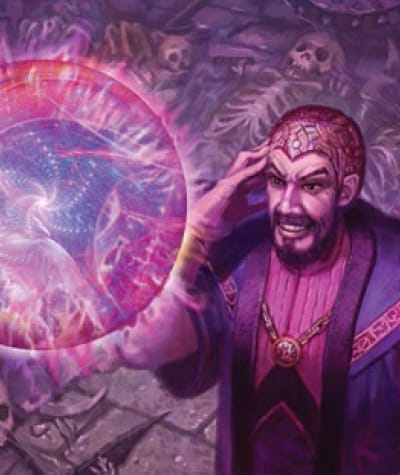 The Cypher Basics
The Cypher Basics
For those not familiar with it, the Cypher System boils down to everything having a level between 1 and 10. To fight, break, unravel or otherwise interact with it, multiply the level by 3 then roll equal or greater than on a twenty-sided dice. That’s about it.
Whenever the player characters want to do anything – and they always have the agency and the dice – they bring all the skills and assets they have to bear, then actually hope not to roll the dice at all. In the perfect world, you just want to succeed because the weight of factors lies in your favour. Where this isn’t the case, then roll.
Problems, hazards and lack of suitable gear increase the difficulty; advantages, good equipment and expertise drop it. If you have a skill, you drop the level. If you have the right tool or gizmo, you drop the level. If someone can help you, the chance improves further.
And the GM hardly ever touches the dice, as the focus stays with the characters. Care to hit someone, then arm yourself, take the higher ground and roll high. When they return the favour and strike back at you, mount your defences, find some cover and roll high to keep out of harms way.
The system drives a very character-focused game, looking to drive entertainment and story over complexity and rules. While the page count might compare to Pathfinder, Paizo’s system holds the lion’s share of the modifiers and crunch compared to Cypher-driven games.
Creating Characters
The first part of the book deals with creating characters. Indeed, the section runs to almost half of the overall page count.
The Cypher System has a phrase for every character. I’m an adjective noun who verbs. You slot three elements into that sentence and come out the other side with a pile of background, relationships, core stats, adjustments and a motivation for getting involved in the first adventure.
For example, you could be a Doomed Author who Sees Beyond or a Craven Wizzard who Fights Dirty.
In Numenera and The Strange, the character Types – the noun in that phrase – carried a very strong thematic edge. From the odd names – like Paradox or Vector – to the specific focus of expertise – stages of increasing expertise and ability, called Tiers – the characters represented a very specialised facet of the background. Here, the Cypher System intentionally holds back from such focus and leaves the way for personalisation wide open.
The game has four base Types – Adept, Warrior, Speaker and Explorer. The previous two games had Types that – from a certain angle – might compare to Wizard, Fighter and Thief. The CSR slices the roguish role down the middle, leaning one way toward the cerebral and charismatic – with the Speaker – and the other way with matters physical and robust – with the Explorer.
In many ways, as I read this, I saw an A-Team analogy coming on. In some measure, Murdock, B.A., Hannibal and Face compare to the Adept, Warrior, Explorer and Speaker.
Now, you probably immediately disagreed with me – especially given the leaning Murdock, for example, has to the mechanical and as a pilot. Well, while previous variants and Character Options might have suggested a little customisation based on swapping like for like, the CSR serves up a selection of Flavors.
Flavors offer custom packages that you can swap elements out from, with abilities all aligned to give a certain edge. So, Murdock might grab Pilot from the Skills Flavor, while B.A. takes Tinker from the Technology Flavor allowing him to repurpose scrapped and discarded devices.
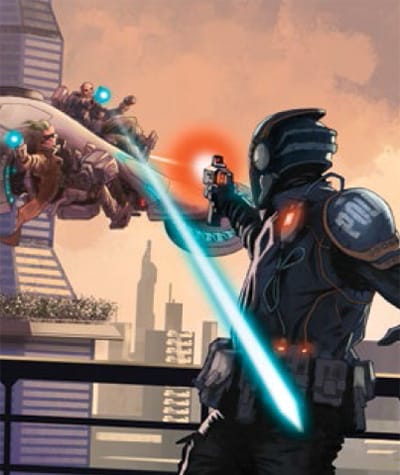 The Descriptors and Foci – adjective and verb – further define and refine the abilities and potential of your character. The first provides a straight bundle of minor adjustments to abilities and skills. Focus expands and grows your potential alongside your Type, improving and expanding as your character accrues experience.
The Descriptors and Foci – adjective and verb – further define and refine the abilities and potential of your character. The first provides a straight bundle of minor adjustments to abilities and skills. Focus expands and grows your potential alongside your Type, improving and expanding as your character accrues experience.
For example, I took a pre-generated character from a Dungeons & Dragons convention adventure and tried out modelling a Cypher version. My Spiritual elf Speaker who Operates Undercover with a Flavor of Combat seemed to fit the bill, handling light weapons while mastering a dash of hedge magic to entertain and distract. It wasn’t a perfect work of conversion from one system to another, but I’m not sure I can see the sense in that.
Notice, I opted for a Spiritual elf rather than a spiritual Elf. Numenera and The Strange have offered an option to play non-human characters, which manifests as a Descriptor. However when you come to the creation process, you may want to emphasize the race or you might prefer to communicate more of the personality representative of that distinct society. I felt it more flavorful to opt for a demeanor driven Descriptor over a race-specific one.
This attempt at conversion wasn’t perfect. However – if you want to play Dungeons & Dragons-style fantasy, you really have a very clear option to just pick up 5th edition. On the other hand, if you want to try your hand at fantasy the way you like it – then the intentionally customizable and open Cypher System could well be your weapon of choice.
For reference, the Cypher System provides all of the foci, descriptors and types with a setting agnostic approach. However, where a Genre applies, or might apply, it offers suggestions for suitable names or ways to theme appropriately. The Focus section, for example, offers boxed lists appropriate by Genre. It does this to speed along selection if you want to opt for something fairly straightforward. However, it also clearly notes that flexibility allows you to run with whatever options you choose. Operates Undercover, for example, is not a suggested Focus for a Fantasy setting, but it seemed to fit my elf conversion. (See A Question of Genre, further down.)
Like Flavors for Types, Descriptors and Foci also include notes on generic swap-outs and structures for building or customising. The game aims to offer optimum flexibility to allow a player to run the character they want to, rather than force their expectations into several cookie-cutter templates with no give or take.
For example, I might want to play a Charming Pie-Maker (which probably equates to some kind of Speaker variant), but I don’t feel the Focus Consorts with the Dead works perfectly, so I’ll work with the GM to find a way to craft a new one. The Tier 1 ability Speaker for the Dead works fine, but the Pie-Maker isn’t really a necromancer, so he doesn’t want to be doing that when he gains sufficient experience to go up a tier. Perhaps Defends the Weak’s Tier 2 abilities Devoted Defender and Astute (which makes him a good judge of others’ motives) would prove a better fit.
Core Rules and Variations
The Rules of the Game presents the core rules of all Cypher System games, which I covered briefly above. It handles the business of completing tasks with dice rolls, skills, assets, effort and so forth, before diving into a number of variations, like combat, hazards and so on.
Those who have experienced the system before will have more interest in the variant and optional rules – and you get those aplenty. However, you will be disappointed if you’re looking to break the system or find anything that robs the game of its uniqueness. For example, you will not find any alternate rules for GM involvement in dice rolls. When your adversary strikes or you fall into a trap, the player continues to keep hold of the dice and rolls for defence or avoidance.
One significant inclusion in the core rules – down as a Special – is Insight. Insight deals with the differential between what a character knows and what a player knows by allowing a point spend to uncover a clue or reasonable additional information. Essentially, if your character might have the trivia or background knowledge to know something, spending three Intellect and expending an action will do the trick.
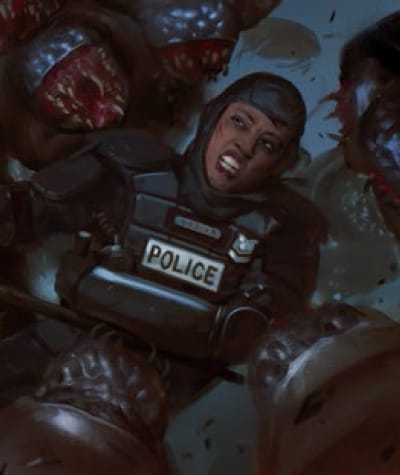 The GM needs to answer truthfully and openly, with the information your character might reasonably know. That doesn’t allow you to shortcut a mystery – so, just because your character is a detective doesn’t mean asking for Insight will get you the culprit behind a murder; it does allow you to know how to complete a thorough search of a crime scene and what activities or tests you might reasonably request of the forensics team.
The GM needs to answer truthfully and openly, with the information your character might reasonably know. That doesn’t allow you to shortcut a mystery – so, just because your character is a detective doesn’t mean asking for Insight will get you the culprit behind a murder; it does allow you to know how to complete a thorough search of a crime scene and what activities or tests you might reasonably request of the forensics team.
The section includes a list of reasonable Insights, to guide both players and GM in using this optional method for gathering information. It makes sense. If you’d know something without much effort, the GM should just provide it; but those things you might not otherwise look for but possess the skills to judge or access – well, they now have a mechanical process for a nudge.
The Optional Rules section ventures into territory left open to GM and group to decide a use for, or not. These variations might suit some but prove too much for others who appreciate the existing simplicity.
To a degree, the variations don’t come as a major surprise, with half of them handling the finer details of combat – something that most sensible players would want their characters to avoid. Because the game doesn’t award combat with experience, the decision to indulge in unnecessary violence becomes a big deal.
Trading Damage for Effect allows you to barter points of damage for more nuanced effects like distracting, disarming, or stunning your opponent. If you deliver sufficient damage, you can switch it out and debilitate your adversary some other way.
Lasting Damage gives more thought to the ongoing impact serious injury might have on characteristic pools. Using Miniatures discusses how you might scratch a tactical itch for those used to battle maps.
Both Optional XP Rules and Complications offer alternate, but not deal-breaking, ways to handle the distribution of experience. As the Cypher System rewards discovery over anything else, characters accrue their experience through quite different activities.
Optional XP Rules posit variations on when and how to reward experience rather than why. For example, players can have their say in who gets XP for their activities during an adventure, or the group might go away with a pool to distribute and come to an agreement between game sessions.
Complications offer experience in an upfront lump sum in return for a pile of GM Intrusion potential. To return to my earlier analogy around The A-Team, that team of characters had various personal and group complications – like actively being hunted by law enforcement or being locked up in a psychiatric institution between missions. In game terms, a character who has an open warrant might get a few XP to expand their abilities, while an A-Team style court martial with several non-player characters actively and persistently in pursuit could offer enough XP to start at Tier 2 from the outset.
It’s an interesting variation on the disadvantages some games offer in character generation to swap out for extra abilities or higher initial attributes.
Finally, Further Customizing Characters considers ways you might tweak and tinker with the whole business of character creation in a sensible way. The previous sections covering Foci, Descriptors and so forth contain their own customization notes. This section gives thought to the weights and measures of character creation.
For example, if a player rolls a background for a character that suggests a career or hobby, can they have the Skill to match? The section offers some thoughts on how you might accommodate this.
Trading Abilities touches on the sort of thing I have already mentioned with my Pie-Maker example – taking an ability from a Type or Focus and swapping it out in a way that considers power and balance. The guidance provides thoughts on weighting one thing against another and seeing if the new options feels more or less powerful.
This isn’t about working everything out point-for-point. It’s about taking a fair guess and running with it. The advice pushes the philosophy that you won’t always get it right and when that becomes clear you should raise your concerns and change it. Just be honest, suggest an alternative and come to an agreement between everyone at the table.
(That’s just a summary of the Optional Rules rather than a verbatim list. The section contains other short sections, mere paragraphs, suggesting other little ideas that might colour and personalise your Cypher game.)
A Question of Genre
The Genres section breaks out into five separate chapters – covering Fantasy, Science Fiction, Modern, Horror and Superheroes – with each getting about 8-pages of coverage. Because Modern covers quite a broad category of possible stories, it overlaps to some extent with Horror and even with Superheroes.
From the earlier sections of the book, the Genre divide has been referenced and highlighted. Within the section on character Focus, each Genre got a box of those suggested appropriate. Under Types, each had a set of example alternate names by genre.
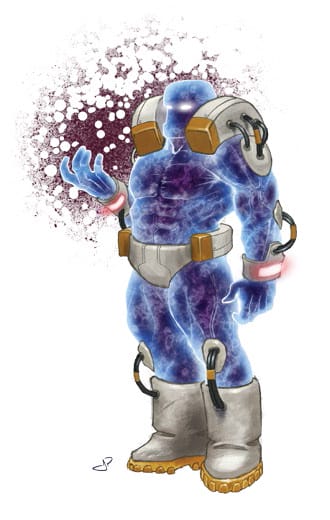 In games like Numenera and The Strange, the named Types established something of the theme – so individual experiences may vary. The Glaive, for example, in Numenera is a type of Warrior with some particular restrictions, like fixed abilities necessitating Practiced in Armor at Tier 1 and Skill With Attacks at Tier 2. If you prefer something a little less rigid, you can allow players to choose from any of the suggested Focus and Description options and let them juggle Types and Flavors to create exactly the character they want.
In games like Numenera and The Strange, the named Types established something of the theme – so individual experiences may vary. The Glaive, for example, in Numenera is a type of Warrior with some particular restrictions, like fixed abilities necessitating Practiced in Armor at Tier 1 and Skill With Attacks at Tier 2. If you prefer something a little less rigid, you can allow players to choose from any of the suggested Focus and Description options and let them juggle Types and Flavors to create exactly the character they want.
The genre specific chapters provide hints on what’s appropriate for each setting and what you might choose to change. Each starts out considering what the genre is – to be certain we’re all on the same page about what makes for a Horror or Fantasy game – and how you would run the game to reinforce that genre choice.
Suggested Types tabulates some common roles – like Druid or Barbarian for the Fantasy genre – and offers thoughts on the best Type and, as appropriate, Flavor. So, a Barbarian is an Explorer with a Combat Flavor while a Druid is also an Explorer with a Magic Flavor.
Another page, per section, outlines suggested Foci, suggested creatures and also other adversaries, beasts and non-player extras that don’t warrant full entries in the Creatures chapter. Rats, bats and common-or-garden villagers all boil down to Level 1 creatures.
Each section also includes genre specific equipment – which warrants stepping sideways for a moment, as I didn’t cover gear in the Character-focused section.
The Cypher System opts for an abstract mechanism to handle equipment and money. When you’re looking to support games in diverse settings, you either adopt a generic currency or go abstract – which is fair enough. If you opt for currencies you face the complexity of setting values, dealing with exchange, and so forth – sinking into a world of minutiae. If abstracts don’t sit well with you, there’s nothing stopping you from adopting whatever monetary system you choose and working out appropriate equipment lists.
Here the system proposes Categories – from Inexpensive through to Exorbitant – and offers comparisons for a sense of scale. Each Genre has a suggested list split by Category, and players and GMs can use this to compare against unlisted items. “Is it worth more or less than a sword? Or a family saloon?”
The Fantasy section includes a brief discussion on Artefacts – which are like Cyphers but persist. Whenever you use such an item, you roll against a Depletion number to see if you run out of charges. They appeared in Numenera and The Strange – and in a fantasy setting they fit perfectly like the stereotypical wand or magic ring.
You’ll also find additional Descriptors here for Dwarf and Elf – useful as a template for creating your own races. Akin to the Fate system approach – seen in the Fate Freeport Companion, for example, I think some players will go with the option of overt Descriptors while those who want to emphasize personality and character will opt for race as background fluff and little more.
The Modern genre is far more straight forward, although it actually covers a lot of ground – anything from the Stone Age through to Post Apocalypse (or pre-starships and zap guns). Various brief sections consider using artefacts and handling historical games – which come down to what you choose to restrict in terms of equipment, cyphers, Flavors and Foci.
Like Modern, Science Fiction also covers a pretty broad span of possibilities from Steampunk through Fringe Science conspiracy on to Space Opera and hard science exploration. As with all the genre options, a GM needs to consider what’s in and what’s out of the setting before doing anything else – as that determines how much of the system the players will have access to in creating their characters.
Science Fiction covers a lot of equipment, including starships, and artificial lifeforms as character Descriptors. The business of space battles and vehicle chases appears in the Rules of the Game – and, as you might expect, boils the detail down as much as possible to Levels and adjustments to difficulty.
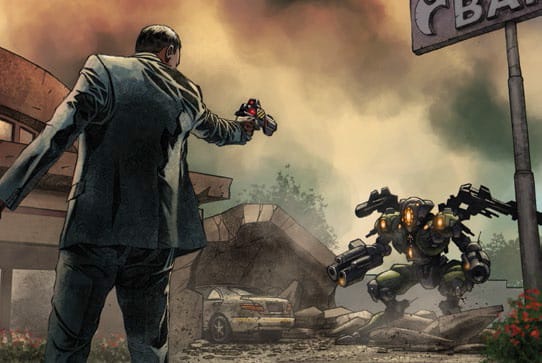 If you picked up In Strange Aeons for Numenera, you will already own some of the material covered in Horror, as the Lovecraftian Glimmer necessarily touched on the business of madness and fear. Running the Game focuses on how to run horror with scares and the unexpected, using atmosphere more than anything else to unnerve the players.
If you picked up In Strange Aeons for Numenera, you will already own some of the material covered in Horror, as the Lovecraftian Glimmer necessarily touched on the business of madness and fear. Running the Game focuses on how to run horror with scares and the unexpected, using atmosphere more than anything else to unnerve the players.
Optional rules consider Shock, Madness and Horror Mode – an escalating mechanic that raises the prospect of GM Intrusion. The section also considers the more general use of GM Intrusion and not generating a sense of repetition in a situation where it becomes more frequent.
In many respects the final Genre – Superheroes – has the easiest fit to the Cypher system, where a Focus like Bears a Halo of Fire or Exists Partially Out of Phase already has a distinct edge of superhero-ness about it. The genre promotes player characters to a state of ultra competence and world focus, with everything stepping up a scale.
Indeed, how do you handle scaling creatures and vehicles for BIG settings like superheroes or Kaiju-battling robots? The section opens up the previously closed scale of 1 to 10 for levels of difficulty and suggests taking it up to 15. As well as opening up really impossible tasks, the section also (optionally) suggests Power Shifts. These represent permanent levels of Effort that mean superheroes and other monstrously powerful entities can reduce the difficulty of tasks that fall into specific categories without draining their core ability pools.
For example, a superhero with immense strength could have three Shifts in Strength tasks. This means any action that involves jumping or inflicting damage on buildings, for example, will have a difficulty three levels lower before you need to start spending Effort or declaring Skills.
A GM will decide how many Power Shifts each player has to work with at the start of the game and those Shifts get assigned to specific categories for the character. You might also choose to allow players to spend XP on acquiring more as part of character development.
As an option for scaling for Superheroes this is something that I would have to play with a bit before drawing an opinion. It has applications outside the Superhero genre, so it needs to have legs as a mechanic. It certainly adheres to the design principles of simplicity and fun, but those open and used to more complexity might be seeking something with more substance.
Myriad Menagerie
The Gamemaster Section starts with chapters on Creatures and NPCs – mirroring the approach of Numenera and The Strange. Creatures deliver a combination of new and old adversaries, selecting a choice few from the previous publications, including Glimmers.
The section includes five Supervillains to kickstart your Superhero genre game, which helps get an understanding of the genre power level. You also have sixty other creatures, running the full range from Level 1 through 10, with Kaiju in the top spot.
Of course, if you’re playing Superheroes, Level 10 might not be the top spot anymore. It might be time to roll out a planet eater or a Category V…
The selection on offer in this section means you should have opposition in a moment for any genre and you can adapt some across genre – like vampires or giant spiders. Of course, the real joy of the Cypher System from a GM perspective is that you can conjure up a brand new adversary by simply choosing a number between 1 and 10. The book offers advice on creating new enemies on the fly, giving them abilities and inabilities as appropriate, along with armour, special attacks and so forth.
Deciphering Cyphers
In Numenera, we discovered cyphers as the Ninth World’s useful rubbish. On a planet layered with the detritus of eons, cyphers and artefacts represented useful garbage, with oddities as mere trinkets and baubles. It made sense. Most cyphers actually represented viable bits of larger devices, their alien construction or purpose making true understanding impossible.
In The Strange, the many worlds of imagination accreted about the Earth came with their own treasures. For some, cyphers would be magical items or cybernetic gizmos. With so many varied worlds, fragmentary planes and pocket universes, cyphers and artefacts represented a haul of viable otherworldly tech.
Making cyphers fit a range of genres… well, that’s a big ask. As the box on the first page of the Cypher chapter points out:
Cyphers are (not surprisingly, based on the name) the heart of the Cypher System.
The system emphasizes that the existence of cyphers adds unpredictability and excitement to your adventures. They represent treasure, so common in other games, but with a value far beyond that of simple money. When you acquire a cypher you don’t just get coins to store in a chest or invest in a henchman, you effectively have a whole new character ability to use in the next adventure – or the very next scene of the current adventure.
The fairly random nature of cyphers – both in powers and level – also means you can throw interesting and exciting curve balls into an adventure without lasting impact. You can have a player blessed with the power to level a city – but only once, as the cypher will burn out, fizzle, dissipate or otherwise vanish after a single use. A one-off device adds new potential without changing the fundamental balance of the game long term.
But, how do these cyphers manifest?
When I looked for comments and hopes on the content of the Cypher system, one response was:
Advice on making Cyphers fit a range of genres. Hopefully not just disposable tech, potions or some other doohickey.
The book suggests that:
In the majority of games, these come in the form of items, like magic potions or bits of alien technology. In others, they’re more esoteric, like inspirations or divine blessings.
I suspect some people might struggle with this and consider it something of a cop out. The book does mention this a couple of times and doesn’t really offer much more guidance. In a fairly straight-laced modern campaign, do you pass all cyphers off as moments of inspiration or good fortune?
 What you do get are generic descriptions of 150 cyphers. One page offers a random table for generating any cypher while another offers a shorter table of subtle cyphers – extracted from the existing 150 – that best suit the sort of game without any overt powered stuff. Subtle Cyphers has a page discussing the idea – and this is the main coverage of using cyphers in a world setting that doesn’t really mesh with their existence.
What you do get are generic descriptions of 150 cyphers. One page offers a random table for generating any cypher while another offers a shorter table of subtle cyphers – extracted from the existing 150 – that best suit the sort of game without any overt powered stuff. Subtle Cyphers has a page discussing the idea – and this is the main coverage of using cyphers in a world setting that doesn’t really mesh with their existence.
I’m not sure what the answer should be – and I found myself slightly disappointed this didn’t get a little more consideration beyond the Subtle Cyphers page. The GM section of the book contains a lot of valuable insight into running the game, but little additional thoughts on cyphers and the conceit of their existence.
I don’t see this as an issue with the system, but each GM will need to discuss the existence of cyphers with his players and give some reason for their presence. They do add fun, with that I cannot argue. However, without a solid explanation for their existence I can see some resistance forming at certain tables.
Finally in respect of Cyphers, most of the descriptions have been made generic, so the 150 listed are effectively powers without form. However, a few still mention the word device – suggesting they’ve come from a source associated with one of the previous iterations of the Cypher system. A minor editing issue.
Running Cypher Games
The advantages of the Cypher System might best boil down to two points: always be bringing on the awesome and it’s not that type of game. OK. I might have paraphrased a little there and possibly made it up a bit, but that’s sort of the point. The system isn’t rocket science and it doesn’t attempt to be.
When you boil a rakish swordsman down to Level 4 non-player character, who’s Level 6 when deceiving with his charms or duelling with a rapier, that simple. If the actions of the characters just got them into a fight with this guy, you’re not going to need to break out the monster manual. He appears out of nothing to ensure you can flow, maintaining the story without need of a pause.
Running the Cypher System spends a lot longer considering how to run the game than either of the previous books. Because this book doesn’t have tons of background material, Monte takes his time over considering what makes the Cypher System different and how a GM can use the simplicity and flexibility to make a better game.
The sections give considerable page-count over to GM Intrusions, non-player characters, awarding experience, handling Cyphers and running a fun game. However, to make a point and quote directly from the book:
The Cypher System is a game that places more importance on creativity than on understanding a mass of rules.
It’s tough to argue with that.
While the character generation system has a pile of options and the freedom this version of the system offers to customise even more, very little here boils down to worrying about modifiers, minutiae or balance. Supporting, valuing and rewarding creativity comes right at the top of the checklist for a good Cypher game.
Final Summary
I found myself formulating the conclusion to this review before writing any of it, probably because the product has a fairly divisive potential. As I have enjoyed the system a great deal, I find that I have to divorce myself from any ultimate judgment. Your view of various gaming principles and the size of your personal collection will likely have a lot to do with whether you go out and buy this book. On the other hand you may have placed a preorder before you even read this far…
In terms of your system preferences, I suspect those who enjoy plenty of well-documented crunch, carefully balanced systems and modifiers for every occasion will not engage with the Cypher System. Since Numenera appeared and Monte explained something of the philosophy of the design, he has made it clear that the game isn’t about the careful balance of characters, abilities and environment. Sometimes one player will be better than another. The game isn’t broken – the system just isn’t written to worry about the minutiae of X being perfectly balanced against Y and Z.
If you have purchased the core books for Numenera and The Strange, own all the Character Option guides and other supplements, and also have every Glimmer released, you have almost everything this book has to offer. Aside from the genre guidelines and the breakout of the third character option into Explorer and Speaker. Some of the genre stuff actually has appeared in other books, like horror in the Lovecraftian Glimmer In Strange Aeons or many aspects of fantasy-focussed character options appearing in The Strange. When you created a character from Aerdyn you had the option for a spell-caster or an elf.
However, the Cypher System Rulebook brings it all together. It gathers many of the scattered elements and presents them as a consistent whole. Monte sticks to his guns and the system continues to deliver the goal of fun over book-keeping. For those who want more crunch, you have a plethora of variant and optional rules scattered throughout the book; for those who find comfort in simplicity, you can ignore as much as you want, knowing that the core mechanic remains the same no matter what.
If you want a simple, flexible system. If you haven’t run a tabletop RPG before and want something that offers breadth and potential. If you want a game that aims to provide fun storytelling with a lightweight rule system. If you’ve played Numenera or The Strange, liked the system, but didn’t quite warm to the setting… Well, I think the Cypher System could work for you.
If it’s any yardstick of a game’s potential, I had ideas for games circulating my cerebrum well before finishing the first read through. I have a steampunk ghost-busting superhero campaign in mind, with Lovecraft, Poe, Tesla and Dickens (quite impossibly) teamed up against gargantuan otherworldly horrors unleashed by the blatant misuse of Science! And I could probably have that game up and running within the hour…
My review is based on an uncorrected pre-release proof provided by the publisher. Cypher System Rulebook , Monte Cook, Bruce R. Cordell, Robert J. Schwalb, Shanna Germain; published by Monte Cook Games. Currently available to pre-order as a PDF or hardback.

